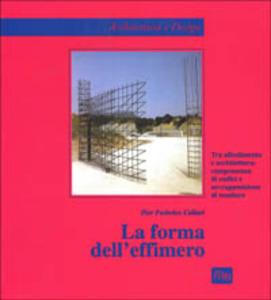Pubblicazioni

La forma dell’effimero. Tra allestimento e architettura: compresenza di codici e sovrapposizione di tessiture
Pier Federico Caliari
Copertina flessibile: 120 pagine
Editore: Lybra Immagine (1 gennaio 2000)
Collana: Architettura e design
Lingua: Italiano
ISBN-10: 8882230422
ISBN-13: 978-8882230425
Peso di spedizione: 699 g
Da una parte l’art, dall’altra l’architettura. Tra le due, l’allestimento come mediazione tra mondi apparentemente sempre più lontani. L’analisi svolta in questo volume, così come il carattere dell’impostazione storiografica, hanno come obbiettivo il disvelamento dei meccanismi che stanno alla base di tale rapporto sotto il profilo del linguaggio e della forma. in particolare, l’allestimento, la tecnica del mostrare, è indicato come topos morfogenetico per l’architettura secondo un percorso, una genealogia che, a partire dall’Umanesimo fino agli albori del Terzo Millennio, crea una continuità tra figure come Paolo III Farnese, Gianlorenzo Bernini, Carlo Scarpa, Aldo Rossi, i “Radicals”, Peter Eisenman, Enric Miralles e altri.
E’ un’analisi che pone l’allestimento come fondamento espressivo per l’architettura nella prospettiva, per quest’ultima, di sfuggire all’oggettivazione di un sapere banalmente normativo, attraverso il libero dispiegamento del “talento” individuale.
Il concetto di “effimero” inteso come categoria estetica, “cronografica”, metaforica è la chiave di volta per la comprensione del nesso arte-allestimento-architettura in un complesso panorama dominato dalla compresenza di codici e dalla sovrapposizione di tessiture. In una parola, dal “palinsesto”.
On one hand art, on the other architecture. Between the two, the set-up as a mediation between seemingly increasingly distant worlds. The analysis carried out in this volume, as well as the character of the historiographical approach, have as their objective the unveiling of the mechanisms that underlie this relationship in terms of language and form. in particular, the layout, the technique of showing, is indicated as morphogenetic topos for architecture according to a path, a genealogy that, from Humanism to the dawn of the Third Millennium, creates a continuity between figures such as Paul III Farnese, Gianlorenzo Bernini, Carlo Scarpa, Aldo Rossi, the “Radicals”, Peter Eisenman, Enric Miralles and others.
It is an analysis that places the set-up as an expressive foundation for architecture in the perspective, for the latter, of escaping the objectification of banally normative knowledge, through the free unfolding of individual “talent”.
The concept of “ephemeral” understood as an aesthetic category, “chronographic”, metaphorical is the key to the understanding of the link art-exhibition-architecture in a complex landscape dominated by the presence of codes and overlapping textures. In a word, from the “palimpsest”.

